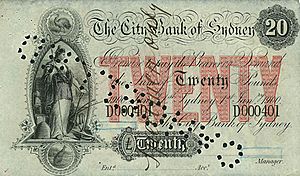Australian Notes Act 1910 facts for kids
Quick facts for kids Australian Notes Act 1910 |
|
|---|---|

Private currency issued by the City Bank of Sydney c. 1900
|
|
| Parliament of Australia | |
| Date assented to | 16 September 1910 |
| Date repealed | 14 December 1920 |
| Status: Repealed | |
The Australian Notes Act 1910 was an important law passed by the Parliament of Australia. It allowed Australia to create its very first national banknotes. This Act, along with the Coinage Act 1909, helped make the Australian pound a unique currency, separate from the British pound.
The government passed this law on 16 September 1910. It was done by the Fisher Labour Government. They used a special power from the Australian Constitution. This power lets the Australian Parliament make laws about "currency, coinage, and legal tender."
This Act gave the Commonwealth Treasury control over printing Australian notes. It also stopped states from printing their own money. The Bank Notes Tax Act 1910, passed soon after, made it very expensive for private banks to print their own notes. This effectively ended the use of private money in Australia.
Contents
How Australia Got Its First Banknotes
When the Australian Notes Act 1910 was new, there was a plan to slowly change over to the new national banknotes.
Using Old Banknotes Temporarily
- In 1911, the Australian Government received blank note forms from 16 different banks.
- These forms were overprinted to show they could be exchanged for gold.
- They were then issued as the very first Commonwealth notes.
- For the next three years, some older private banknotes were also overprinted by the Treasury.
- These overprinted notes were used as Australian banknotes.
- This continued until new designs were ready for Australia's first official federal government banknotes.
- The first fully new Australian banknotes started being used in 1913.
What Happened After the Act
The Australian Notes Act 1910 was an important step. However, it was later replaced by new laws.
New Laws for Banknotes
- The Australian Notes Act 1910 was cancelled on 14 December 1920.
- This happened when the Commonwealth Bank Act 1920 was passed.
- This new Act gave the power to print notes to the Commonwealth Bank.
- Later, in 1960, the job of printing banknotes moved again.
- This time, the responsibility went to the Reserve Bank of Australia (RBA).
Rules About Private Money Today
- Today, a section of the Reserve Bank Act 1959 still stops private and state currencies.
- Section 44(1) of this Act says that no person or state can issue a "bill or note for the payment of money payable to bearer on demand and intended for circulation."
- This means that only the official central bank can create money for everyone to use.
See Also
- Section 51(xii) of the Australian Constitution
- Australian dollar
- Bank Notes Tax Act 1910

